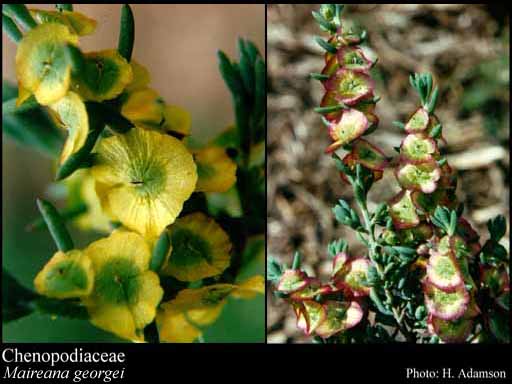- Reference
- Tabl.Regn.Vég. 2:253 (1799)
- Name Status
- Current

Scientific Description
Common name. Goosefoot Family.
Habit and leaf form. Herbs (mostly), or herbaceous climbers, or shrubs (some), or trees (few, small), or lianas (few). ‘Normal’ plants and switch-plants; sometimes more or less ‘cactoid’ (e.g. Salicornia). Leaves well developed, or much reduced, or absent. Plants succulent, or non-succulent; spiny, or unarmed. The spines axial. Annual, or biennial, or perennial (often glaucous); plants with a basal concentration of leaves, or with neither basal nor terminal concentrations of leaves. Self supporting (usually), or climbing (few). Helophytic to xerophytic (nearly all halophytic). Leaves minute to large; alternate, or opposite; when alternate, spiral, or distichous (rarely); with blades, or bladeless (often, when reduced); ‘herbaceous’, or fleshy, or membranous; petiolate to sessile; connate (not infrequently, when reduced-opposite and associated with succulent internodes), or not connate; sheathing, or non-sheathing; simple; epulvinate. Leaf blades dissected, or entire; when present, one-veined, or pinnately veined; hastate, or sagittate, or attenuate at the base, or cuneate at the base. Leaves without stipules; without a persistent basal meristem. Leaf anatomy. Hydathodes present (sometimes), or absent. Stem anatomy. Nodes unilacunar. Secondary thickening developing from a conventional cambial ring, or anomalous; when anomalous, via concentric cambia (very commonly), or from a single cambial ring.
Reproductive type, pollination. Fertile flowers hermaphrodite, or functionally male and functionally female, or hermaphrodite and functionally female, or functionally male (rarely), or functionally female (rarely), or hermaphrodite, functionally male, and functionally female. Unisexual flowers present, or absent. Plants hermaphrodite (usually), or monoecious (sometimes), or andromonoecious (rarely), or gynomonoecious, or dioecious (rarely), or polygamomonoecious.
Inflorescence and flower features. Flowers solitary, or aggregated in ‘inflorescences’; when solitary, axillary; in cymes (the cymes mostly in racemose arrangements). The terminal inflorescence unit cymose. Inflorescences terminal, or axillary; mostly racemes of cymes. Flowers minute, or small; regular; cyclic; when hermaphrodite, usually tricyclic (sometimes 2-cyclic). Free hypanthium present (when the stamens are ‘inserted on a disk on the perianth’), or absent. Hypogynous disk often present (but not always?). Perianth sepaline (herbaceous or membranous), or vestigial to absent; (1–)5(–6); 1 -whorled; joined (imbricate); fleshy, or non-fleshy; persistent; accrescent, or non-accrescent. Calyx (interpreting the perianth as such) present, or vestigial, or absent; (1–)3–5(–6); gamosepalous; entire, or lobed; imbricate; fleshy (commonly), or non-fleshy (then usually herbaceous or membranous); persistent (in the fruit); accrescent, or non-accrescent. The fruiting calyx berrylike, or not berrylike. Corolla absent. Fertile stamens present, or absent (from female flowers). Androecium 3–5. Androecial members free of the perianth, or adnate (to the base of the perianth); all equal (by contrast with most Amaranthaceae); free of one another (mostly, by contrast with most Amaranthaceae), or coherent; when coherent 1 - adelphous (connate at the base); 1 -whorled. Androecium exclusively of fertile stamens. Stamens 3–5; usually isomerous with the perianth; oppositisepalous. Anthers bent inwards in bud; dehiscing via longitudinal slits; tetrasporangiate. Fertile gynoecium present, or absent (from male flowers). Gynoecium (2–)5 carpelled. The pistil 1 celled. Gynoecium syncarpous; synovarious to synstylovarious; superior (usually), or partly inferior (rarely). Ovary unilocular; 1 locular. Gynoecium stylate, or non-stylate to stylate. Styles (1–)2–3(–4); usually partially joined; apical. Stigmas dry type; papillate; Group II type. Placentation basal. Ovules in the single cavity 1; pendulous, or ascending; non-arillate; campylotropous.
Fruit and seed features. Fruit non-fleshy; indehiscent, or dehiscent; a nut, or a berry, or a capsule (rarely), or capsular-indehiscent; enclosed in the fleshy receptacle, or enclosed in the fleshy hypanthium, or enclosed in the fleshy perianth, or without fleshy investment. Capsules when dehiscent, circumscissile. Gynoecia of adjoining flowers combining to form a multiple fruit, or not forming a multiple fruit. Seeds more or less non-endospermic. Perisperm present, or absent (of classificatory interest). Seeds with starch. Cotyledons 2. Embryo chlorophyllous (5/11), or achlorophyllous (3/5 (Atriplex, Chenopodium, Beta)); coiled (usually), or curved, or bent. Seedling. Germination phanerocotylar.
Physiology, biochemistry. Aluminium accumulation not found. Plants often accumulating free oxalates. Photosynthetic pathway: C3, or C4.
Geography, cytology, number of species. World distribution: widespread, but missing from Central America, Asia, Malaysia and most of Africa. X = (6–)9. 1400 species.
Economic uses, etc. Contributes sugarbeet and Swiss chard (Beta vulgaris), spinach (Spinacia oleracea), and ‘saltbush’ pastures.